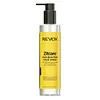What's inside
What's inside
 Key Ingredients
Key Ingredients

 Benefits
Benefits

 Concerns
Concerns

 Ingredients Side-by-side
Ingredients Side-by-side

Water
Skin ConditioningSodium C14-16 Olefin Sulfonate
CleansingCocamidopropyl Hydroxysultaine
CleansingSorbitol
HumectantPropylene Glycol
HumectantGluconolactone
Skin ConditioningSalicylic Acid
MaskingSodium Benzoate
MaskingSodium Hydroxide
BufferingPotassium Acrylates Copolymer
Acrylates/C10-30 Alkyl Acrylate Crosspolymer
Emulsion StabilisingCitric Acid
BufferingDisodium EDTA
2,6-Dimethyl-7-Octen-2-Ol
MaskingMethyldihydrojasmonate
MaskingTricyclodecenyl Propionate
MaskingTetramethyl Acetyloctahydronaphthalenes
MaskingWater, Sodium C14-16 Olefin Sulfonate, Cocamidopropyl Hydroxysultaine, Sorbitol, Propylene Glycol, Gluconolactone, Salicylic Acid, Sodium Benzoate, Sodium Hydroxide, Potassium Acrylates Copolymer, Acrylates/C10-30 Alkyl Acrylate Crosspolymer, Citric Acid, Disodium EDTA, 2,6-Dimethyl-7-Octen-2-Ol, Methyldihydrojasmonate, Tricyclodecenyl Propionate, Tetramethyl Acetyloctahydronaphthalenes
Water
Skin ConditioningSodium Lauryl Sulfate
CleansingGlycerin
HumectantSodium Lauroyl Sarcosinate
CleansingCocamidopropyl Betaine
CleansingPEG-40 Hydrogenated Castor Oil
EmulsifyingGluconolactone
Skin ConditioningLactic Acid
BufferingGlycolic Acid
BufferingCitric Acid
BufferingMalic Acid
BufferingSalicylic Acid
MaskingCentella Asiatica Extract
CleansingSodium Hyaluronate
HumectantMelaleuca Alternifolia Leaf Extract
PerfumingHydroxyethylcellulose
Emulsion StabilisingMelaleuca Alternifolia Leaf Oil
AntioxidantPhenoxyethanol
PreservativeAlcohol Denat.
AntimicrobialParfum
MaskingSodium Benzoate
MaskingPotassium Sorbate
PreservativeDisodium EDTA
Water, Sodium Lauryl Sulfate, Glycerin, Sodium Lauroyl Sarcosinate, Cocamidopropyl Betaine, PEG-40 Hydrogenated Castor Oil, Gluconolactone, Lactic Acid, Glycolic Acid, Citric Acid, Malic Acid, Salicylic Acid, Centella Asiatica Extract, Sodium Hyaluronate, Melaleuca Alternifolia Leaf Extract, Hydroxyethylcellulose, Melaleuca Alternifolia Leaf Oil, Phenoxyethanol, Alcohol Denat., Parfum, Sodium Benzoate, Potassium Sorbate, Disodium EDTA
Ingredients Explained
These ingredients are found in both products.
Ingredients higher up in an ingredient list are typically present in a larger amount.
Citric Acid is an alpha hydroxy acid (AHA) naturally found in citrus fruits like oranges, lemons, and limes.
Like other AHAs, citric acid can exfoliate skin by breaking down the bonds that hold dead skin cells together. This helps reveal smoother and brighter skin underneath.
However, this exfoliating effect only happens at high concentrations (20%) which can be hard to find in cosmetic products.
Due to this, citric acid is usually included in small amounts as a pH adjuster. This helps keep products slightly more acidic and compatible with skin's natural pH.
In skincare formulas, citric acid can:
While it can provide some skin benefits, research shows lactic acid and glycolic acid are generally more effective and less irritating exfoliants.
Most citric acid used in skincare today is made by fermenting sugars (usually from molasses). This synthetic version is identical to the natural citrus form but easier to stabilize and use in formulations.
Read more about some other popular AHA's here:
Learn more about Citric AcidDisodium EDTA plays a role in making products more stable by aiding other preservatives.
It is a chelating agent, meaning it neutralizes metal ions that may be found in a product.
Disodium EDTA is a salt of edetic acid and is found to be safe in cosmetic ingredients.
Learn more about Disodium EDTAGluconolactone is a PHA. PHAs are a great gentle alternative to traditional AHAs.
When applied, Gluconolactone has the same affect on skin as AHAs such as lactic acid. It helps dissolve the dead skin cells in the top layer of your skin. This improves texture and brightens the skin.
PHAs are more gentle than AHAs due to their larger structure. They do not penetrate as deeply as AHAs and take a longer time to dissolve dead cells. Studies show PHAs do not cause as much irritation.
Gluconolactone has some interesting properties:
In a 2004 study, Gluconolactone was found to prevent UV damage in mouse skin cells and has not been found to increase sun sensitivity. However, we still recommend wearing SPF daily.
This ingredient is is an created by reacting gluconic acid with an alcohol.
Learn more about GluconolactoneSalicylic Acid (also known as beta hydroxy acid or BHA) is a well-known ingredient for treating skin that struggles with acne and clogged pores. It exfoliates both the skin's surface and deep within the pores to help clear out buildup, control oil, and reduce inflammation.
Unlike AHAs (alpha hydroxy acids), salicylic acid is oil-soluble. This allows it to penetrate into pores which makes it especially effective for treating blackheads and preventing future breakouts.
Salicylic acid is also known for its soothing properties. It has a similar structure to aspirin and can calm inflamed or irritated skin, making it a good option for acne-prone skin that is also sensitive.
Concentrations of 0.5-2% are recognized by the U.S. FDA as an over-the-counter topical acne product.
It can cause irritation and/or dryness if one's skin already has a compromised moisture barrier, so it's best to focus on repairing that before introducing this ingredient into your routine.
While salicylic acid does not increase sun sensitivity, it’s still important to wear sunscreen daily to protect your skin.
If you are looking for the ingredient called BHA or Butylated Hydroxyanisole, click here.
Learn more about Salicylic AcidSodium Benzoate is a preservative. It's used in both cosmetic and food products to inhibit the growth of mold and bacteria. It is typically produced synthetically.
Both the US FDA and EU Health Committee have approved the use of sodium benzoate. In the US, levels of 0.1% (of the total product) are allowed.
Sodium benzoate works as a preservative by inhibiting the growth of bacteria inside of cells. It prevents the cell from fermenting a type of sugar using an enzyme called phosphofructokinase.
It is the salt of benzoic acid. Foods containing sodium benzoate include soda, salad dressings, condiments, fruit juices, wines, and snack foods.
Studies for using ascorbic acid and sodium benzoate in cosmetics are lacking, especially in skincare routines with multiple steps.
We always recommend speaking with a professional, such as a dermatologist, if you have any concerns.
Learn more about Sodium BenzoateWater. It's the most common cosmetic ingredient of all. You'll usually see it at the top of ingredient lists, meaning that it makes up the largest part of the product.
So why is it so popular? Water most often acts as a solvent - this means that it helps dissolve other ingredients into the formulation.
You'll also recognize water as that liquid we all need to stay alive. If you see this, drink a glass of water. Stay hydrated!
Learn more about Water